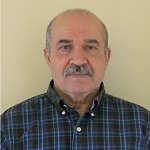Dr. Nacer Koiuder M’Sirdi :
Biography:
Nacer K M’Sirdi is professor at Polytech Marseille and
Aix Marseille University (AMU) from February 2005. He got
the Phd in Electronics at ENSERG shool of INPG Grenoble (1983) and the Doctorat d’Etat in adaptive signal processing for non-stationary signals at the ENSIEG of INPG,
Grenoble, in 1988 (Laboratory of Automatic of Grenoble).
He was assistant professor, in signal processing and automatic control, in University of Paris 6 in 1987 and Professor at University of Versailles in 1993. He was the dean
of the research Laboratory of Robotics of Versailles (the LRV that he has
created in 1999), from 2000 to 2004. From 2005 up to now, he is a research member of the LSIS (UMR CNRS 7296 which became the LIS UMR
7020). His main research activities deal with adaptive and robust control,
signal processing, diagnosis and observation for complex systems such as
vehicles and robots. In 2009 he has created the VSAS research project on
Variable Structure Automatic Systems (SASV), for fundamental research in
automatic control and optimization. Applications of his research activities
deal in one hand on vehicles and autonomous robots applications and in
another hand on Modeling Analysis and Control of Systems with Multiple
Energy sources. Recently. He created the MERIE network (Mediterranean
Efficient and Renewable Intelligent Energies) inside the RMEI network in
2011. The aim of this group (see http://nkms.free.fr/MGEF/MGEN.htm) is
to promote compatible and Efficient Renewable Energies in Mediterranean
Countries. Recently NK M’Sirdi has created the HyRES Lab, an international open collaboration laboratory which includes up to 14 Mediterranean cooperating teams coming from 8 different mediterranean countries (see http://nkms.free.fr/MGEF/HyRESLab.htm). He is the Chair of
the MGEF: Mediterranean Green Energy Forum, created in SEB 2011: see
http://nkms.free.fr/MGEF/MGEF2015.htm.
https://cv.archives-ouvertes.fr/k-nacer-msirdi
Abstract: Autonomous Vehicle Platooning and Motion Control Models and Control Approaches? Features and characters
Several projects deal with vehicle platooning (or a collection of coordinated vehicles travelling together). Among the advantages of platooning
we can note fuel or energy economy, traffic efficiency, safety and driving comfort. In the literature Vehicle Platooning can be classified into 5 categories or
more:
- Trajectory Planning
- Inter-Vehicle Communication and information Exchanges
- Collision Avoidance and Obstacle Detection
- String Stability of a fleet
- Vehicle Fleet Control (Lateral and Longitudinal).
This note presents an overview on vehicle platooning and specifically on
the modeling and control strategies of a fleet of road vehicles.
The preferred modeling approach is that of robotics considering the geometric, the kinematic and the dynamic models. The vehicles motion representation is of a main importance for the control of a fleet. This model is more
complete to describe a motion and allows to better describe the behavior of the
vehicles and especially to better control their movements and the trajectories
tracking. We will then propose an appropriate model with bilateral couplings
for fleets of road vehicles, for a large number of vehicles.
The control problem is then studied and several strategies are considered
(local, global and mixed). The application of nonlinear robust control approaches gives the fleet a better controlled and more robust behavior against
uncertainties. Then, we present a contribution in the control and observation
of the state of the system.
Keywords: Vehicle Dybamics · Modeling and Control · Vehicle Platooning.




















